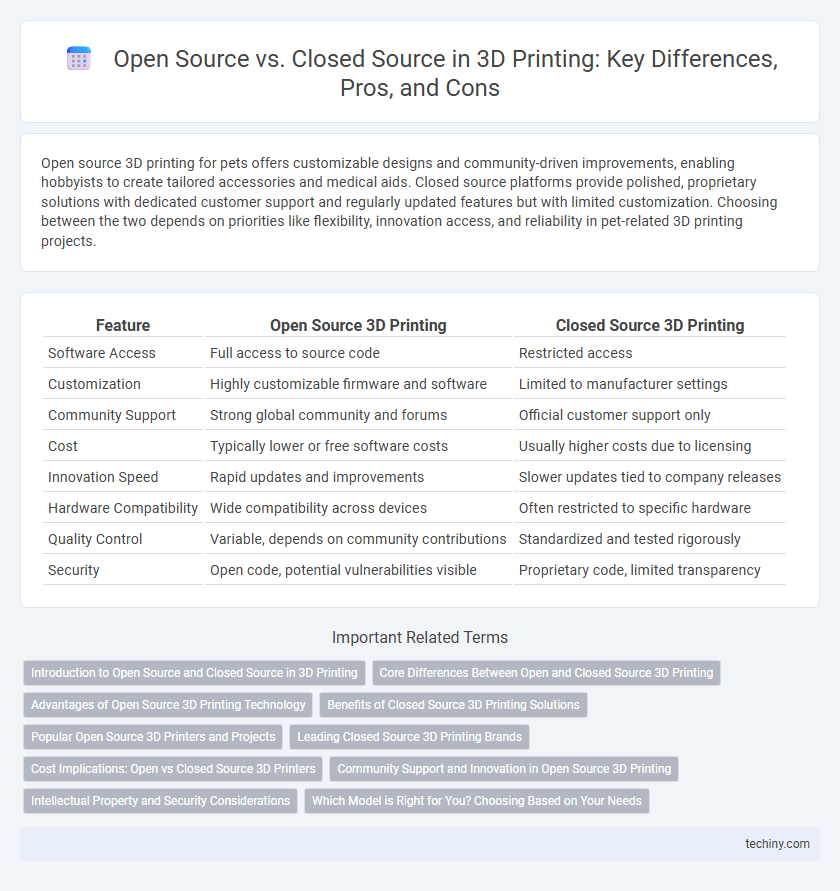Open source 3D printing for pets offers customizable designs and community-driven improvements, enabling hobbyists to create tailored accessories and medical aids. Closed source platforms provide polished, proprietary solutions with dedicated customer support and regularly updated features but with limited customization. Choosing between the two depends on priorities like flexibility, innovation access, and reliability in pet-related 3D printing projects.
Table of Comparison
| Feature | Open Source 3D Printing | Closed Source 3D Printing |
|---|---|---|
| Software Access | Full access to source code | Restricted access |
| Customization | Highly customizable firmware and software | Limited to manufacturer settings |
| Community Support | Strong global community and forums | Official customer support only |
| Cost | Typically lower or free software costs | Usually higher costs due to licensing |
| Innovation Speed | Rapid updates and improvements | Slower updates tied to company releases |
| Hardware Compatibility | Wide compatibility across devices | Often restricted to specific hardware |
| Quality Control | Variable, depends on community contributions | Standardized and tested rigorously |
| Security | Open code, potential vulnerabilities visible | Proprietary code, limited transparency |
Introduction to Open Source and Closed Source in 3D Printing
Open source 3D printing provides users with publicly accessible design files and software, fostering collaboration and innovation within the community. Closed source 3D printing systems feature proprietary hardware and software controlled by manufacturers, often limiting customization but ensuring standardized quality and support. Understanding these differences influences decisions related to cost, flexibility, and long-term project development in additive manufacturing.
Core Differences Between Open and Closed Source 3D Printing
Open source 3D printing provides users with freely accessible design files, software, and hardware schematics, enabling extensive customization and community-driven innovation. Closed source 3D printing restricts access to proprietary technology and software, prioritizing user-friendly interfaces and guaranteed support but limiting modification and collaboration. The core differences revolve around transparency, flexibility, and control over the printing process, impacting costs, adaptability, and the pace of technological advancement.
Advantages of Open Source 3D Printing Technology
Open source 3D printing technology offers significant advantages including increased customization, community-driven innovation, and cost-effectiveness by providing freely accessible design files and software. This accessibility fosters rapid development cycles and collaborative problem-solving among hobbyists and professionals alike. Open source models also enhance transparency and interoperability, allowing seamless integration with various hardware and software platforms.
Benefits of Closed Source 3D Printing Solutions
Closed source 3D printing solutions provide enhanced security and intellectual property protection by restricting access to proprietary software and hardware designs. These systems often deliver superior customer support, regular updates, and optimized performance through tightly integrated hardware and software. Businesses benefit from reliable, consistent results and reduced risk of unauthorized modifications or piracy.
Popular Open Source 3D Printers and Projects
Popular open source 3D printers such as the Prusa i3 and Creality Ender series set industry standards by offering customizable hardware and accessible firmware, fostering innovation through community collaboration. Open source projects like Marlin firmware and OctoPrint provide user-friendly interfaces and extensive compatibility, enhancing print quality and workflow efficiency. These platforms empower makers and developers to modify and improve designs, promoting rapid prototyping and cost-effective production in the 3D printing ecosystem.
Leading Closed Source 3D Printing Brands
Leading closed source 3D printing brands such as Stratasys, MakerBot, and Formlabs dominate the market by offering proprietary technologies that ensure high precision, reliability, and user support. These companies invest heavily in R&D, delivering advanced materials, patented hardware, and integrated software ecosystems to optimize print quality and workflow efficiency. Their closed source approach enhances security and intellectual property protection, appealing to industries like aerospace, automotive, and healthcare where precision and compliance are critical.
Cost Implications: Open vs Closed Source 3D Printers
Open source 3D printers typically have lower cost implications due to freely available designs and community-driven modifications, reducing initial investment and maintenance expenses. Closed source 3D printers often involve higher upfront costs because of proprietary technology, licensing fees, and limited customization options. Users choosing open source benefit from reduced material costs and widespread third-party part availability, making them more budget-friendly for hobbyists and small businesses.
Community Support and Innovation in Open Source 3D Printing
Open source 3D printing fosters robust community support, enabling users and developers worldwide to collaborate on design improvements and troubleshooting. This collective innovation accelerates the evolution of printing technologies, resulting in rapid enhancements and diverse material compatibility. Community-driven projects often lead to cost-effective solutions and customizable hardware that closed source models may not provide.
Intellectual Property and Security Considerations
Open source 3D printing allows users to modify and share design files freely, promoting innovation but raising concerns over intellectual property (IP) infringement and unauthorized replication. Closed source systems protect IP through restricted access and licensing, enhancing security but limiting collaborative development. Balancing these models requires careful management of IP rights and cybersecurity measures to safeguard proprietary designs while fostering technological advancement.
Which Model is Right for You? Choosing Based on Your Needs
Open source 3D printing software offers customization, community support, and cost-effectiveness, ideal for hobbyists and developers who value flexibility and innovation. Closed source solutions provide proprietary technology, dedicated support, and streamlined user experience, suited for businesses requiring reliability and professional-grade features. Selecting the right model depends on your technical expertise, budget, and whether you prioritize adaptability or consistent performance.
Open Source vs Closed Source Infographic

 techiny.com
techiny.com